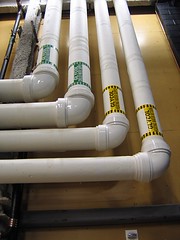Fun and profit can come in unexpected ways to energy efficiency engineers. A couple of months ago while at a jobsite conducting central air handler control testing, there was the inevitable wait-around time. So I stopped to take a look at a central heating hot water plant we commissioned a couple of years ago. It’s a basic system - an all-primary layout with two boilers and variable flow 7.5 horsepower pumps, controlled by a piping differential pressure (DP) control sensor located in a remote section of the distribution piping. The plant serves a few dozen single duct VAV box reheat coils. A pretty typical system.
The DP Reset Test
It was a moderate 50°F day with hot water supply (HWS) temperatures in the low 140°F range, holding a relatively low 5.0 PSI fixed differential pressure control setpoint. The pump was running at about 58% speed and using about .70 kW of power. To see what would happen, I changed the DP setpoint to 2.0 PSI. Two hours later, the pump power dropped from .70 kW to a remarkable .30 kW. Yet the system was easily meeting the low-load thermal needs of the terminal reheat coils.
Savings Seen Before
A year earlier, while commissioning the heating hot water plant controls for a major building renovation, we discovered the control technician had increased heating hot water pump DP setpoint from 4.0 PSI to 8.0 PSI. The technician made the change because a few zones were having heating problems. The weather was cool, in the 40°F range. The heating HWS temperature was found with a reset schedule which was too aggressive (HWS temperature was too cool during moderate weather). So the HWS reset was adjusted to be warmer and the DP setpoint changed back to the original 4.0 PSI setpoint. That solved the heating problems.
What really caught our attention was the pump power reduction from 4.5 kW to only .80 kW, fifteen minutes after adjusting the DP setpoint lower. This wasn’t a fair power vs. setpoint test; a system really needs an hour or so to stabilize and truly settle down, so the savings would probably be a little lower. But the quick and dirty savings calcs we did on the fly were impressive: about 22,000 kWh per year. That’s worth about $2,600 per year, using Vermont’s average commercial electrical rate of about $ .12 kWh.
And by the way, further functional testing identified the pump variable speed drive (VFD) was setup with a 20% minimum speed, which created piping over-pressurization during low demand, with actual pressures greater than the 4.0 PSI setpoint. Changing the VFD min speed from 20% to 10% resulted in dropping the pump power even further, from .80 kW to only .30 kW.
The magnitude of these casual, very simple DP “what if” tests made me wonder why we, as an industry, have continued to use a practice of maintaining a constant, fixed high pressure setpoint. A high pressure setpoint is only needed during a full load “design day” as we say in this business.
Resetting variable flow pumping pressure setpoints lower during moderate weather allows the pump to work much easier, as the pump motor power reductions indicated. The cumulative annual savings can be significant because there are a LOT of annual hours with temperatures in the 30°F to 65°F range where resetting the DP setpoint lower can readily be applied. For example, in the Burlington, Vermont region, there are about 5,500 hours per year with temperatures in this 30°F to 65°F range where DP reset can be applied.
Uncommon Practice
Yet, to my knowledge, there is only one engineering firm in our region that applies this DP reset practice. Applying DP reset is neither expensive nor complicated. No additional hardware is needed, just some additional programming, which my guess is can be done for probably less than $500.
DP Reset Methods
What methods can be applied for resetting a pump DP setpoint? Outside air temperature based reset, where the DP setpoint becomes higher as outside temperatures become colder is a very common reset algorithm used in our industry. This is perhaps the simplest method and a method likely to persist.
There are other methods, such as looking at terminal equipment control valve positions. When a terminal control valve modulates to greater than 90% open, increase the DP setpoint .1 PSI higher. Reverse the sequences as the valve modulates towards closed. Having said that, the sequence will never work in the real world. Inevitably, there will be a few “rogue” zones - problem zones which, for a variety of reasons, are always “calling.” Providing the building operator with the capability to easily ignore such rogues will enhance the persistence.
New ASHRAE Standard Requires DP Reset
This past weekend I was sitting around the living room reading the newest version of the primary energy code in the US, ASHRAE Standard 90.1-2010, “Energy Standard for Buildings Except Low-Rise Residential Buildings.” Yes, I really do have a life, but sometimes, as happened over the weekend, “work” and “fun” comingled. And I was pleasantly surprised to find pumping DP reset is now required. So in a few years, as various states update their state energy codes, we’ll see DP reset as business as usual.
That makes sense to me - the economics clearly indicate this is economically viable. Low hanging fruit - so low you’ll bump into it.
Your Experience?
Have you ever applied pumping DP reset? What techniques worked well for you, and were there any that did not work so well? What kind of power savings did you find? Please join the conversation in our comments section below or find us on Twitter - @CxAssociates.






